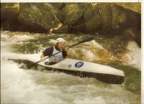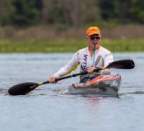- Posts: 60
- Thank you received: 15
A Question for the technically minded
The reason I ask is after seeing Tim Jacobs paddling his Nelo 560 to second place in fairly flat conditions in the recent World Champs. He is giving up close to 80cm on most elite level boats doing the rounds these days.
I would think for intermediate level paddlers it wouldn't make a huge difference but at the pointy end of elite paddling every little advantage or disadvantage means a big difference in overall performance.
I guess the benefits of the shorter ski is increased manoeuvrability when chasing runs. It seems that most manufacturers have hit a "sweet spot" of around 6.4 meters for their elite craft. Is Nelo challenging this theory? Or is it just a one off experiment ski?
Cheers
Please Log in or Create an account to join the conversation.
- Posts: 177
- Thank you received: 23
the science of paddling series covers a lot of the answers better than i can put it www.surfski.info/getting-started/tips-ot...addling-part-iv.html
look for the other articles at the bottom of that page
Please Log in or Create an account to join the conversation.
Cheers
Please Log in or Create an account to join the conversation.
I think most surf ski manufacturers are up at 6.4m or so for their elite skis, not because they're faster, but because they work well in open-ocean swell for the "big guys", the prototypical 6' / 90kg bruisers who make up the top echelon of pros. In other words, they're tailor-made to win the Molokai race. But for the average "normal" paddler who isn't a pro male and is paddling flatter water or shorter swells (which is normally the case, despite our fantasies), they're actually too long and have too much volume. For most of us, they're just plain too big.
Please Log in or Create an account to join the conversation.
Creativity Cures Complacency
Please Log in or Create an account to join the conversation.
- kayakchampeen
-

- Offline
- Senior Member
- Posts: 72
- Thank you received: 45
It doesn't surprise me that shorter boats can be surprisingly fast as I can keep up with V12's on flatwater (for a while at least!) in an 4.5 meter ICF wildwater boat that is suprisingly narrow at the waterline, has a higher prismatic coefficient than most skis, effectively no rocker, no rudder for added resistance, and will accelerate much faster than a ski.
That said, K1's are as short as they are b/c the rules limit the to 5.2meters long. This is why they have to be so skinny to achieve the speeds they do. They would certainly be closer to about 19ft if the rules allowed it. To state the obvious, One can make a 19ft ski much faster than a typical elite ski if it is designed to be more "K1 like". The likely tradeoffs being downwind speed and far greater tippiness. Also the nelo 560 for instance is more K1 like in it's outfitting than many ocean ski's making for greater possible application of power. I'm guessing 50-75% of the ski owners in the world are on a ski that is too long for their weight or intended application. Big boys in the big swell are the only people who can benefit from a 21.5ft boat of any kind. Until recently, all of the shorter skis were beamier and aimed squarely at intermediate paddlers. It is great to see someone designing smaller, faster skis for serious speed in other conditions and for smaller folks.
BTW Those ridiculous 23ft boats you see for adventure racing are a joke, they aren't any faster for any purpose and will soon be on the scrap heap.
Please Log in or Create an account to join the conversation.
What he said...
Please Log in or Create an account to join the conversation.
Please Log in or Create an account to join the conversation.
Black is the new redHiro wrote: The length of the ski has absolutely no effect. A red ski will make you go faster !
Please Log in or Create an account to join the conversation.
- red_pepper
-

- Offline
- Elite Member
- Posts: 302
- Thank you received: 30
Your Mohican was the first one that I made. After trying about a dozen kayaks over three years with the intent of finding one that that had a comfortable sitting position like an ICF race boat with a narrow foredeck that was about the same speed with good glide and was just stable enough to learn good technique and paddle in the winter without constant worry about having a chilling swim, I reluctantly decided that I had to take the time to design one to fill the void. I spent nearly two years working on the design to find the optimum balance of speed, comfort, stability, and seaworthiness that I was looking for. I was hoping to build a boat around 18 or 19 feet long, but was not able to get the resistance low enough at that length for my weight, so modeled designs until I reached 21 feet. I was fortunate to have excellent towing tank tests for over a dozen kayaks and design codes that I had developed using test data from rowing shells to fast slender ships.
Please Log in or Create an account to join the conversation.
- YBA/Jim Murray
- Offline
- Premium Member
- Posts: 154
- Thank you received: 7
Interestingly, an ICF K2 is 6.5 metres long-21.3 feet. I wonder how many surfskis were developed from those hulls and adapted to ocean paddling, evolving by trial and error to the boats seen today. Paddlers not so long ago built and raced there own boats and paddles. Sometimes it was a spectacular failure
Jim
Please Log in or Create an account to join the conversation.
Latest Forum Topics
-
- Replacing rudder line Nelo
- 4 days 1 hour ago
-
- Puerto Rico
- 5 days 13 hours ago

